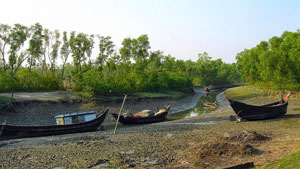
Bangladesh is growing in land size
Md. Saifullah Khaled | Thursday, 26 March 2015

Bangladesh with 147,570 km² in size and a population of more that 160 million is one of the most densely populated countries in the world. In the last four decades the size of its population has more than doubled. As a result, the arable land area has been reduced because of the increasing demand for constructing dwelling houses, educational institutions, roads and highways, mills and factories, infrastructure and other socio-economic and religious installations et cetera.
Against this backdrop, the possibility of the availability of a considerably large size of land area along the coastal belt of the country is good news for us. If it is possible and feasible to reclaim land in the coastal belt then we may hope to overcome the current scarcity of land to some extent.
An account of the Forest Department shows that several years back 4444 trees were planted in a plot of 2.5 acres of land in a small char in the coastal belt. The number of trees has by now increased to 20 thousand from the seeds of those planted trees through natural course. New efforts have been made to plant trees in 271 acres of land in the region. Netherlands has reclaimed a huge amount of land from its coastal belt through this process. They are now assisting Bangladesh also in this regard through supplying necessary funds and appropriate consultancy services.
Some optimists forecast that a new Bangladesh is emerging in the mouth of the Bay of Bengal. They claim that the size of the country has increased in the last 44 years by about 12 hundred square miles because of the reclamation of land in the coastal areas. The area of new land that is going to be added to the mainland this year is about 22 hundred square miles. The char lands that have already surfaced in the mouths of different rivers of the southern region of the country may be reclaimed. This will add another 15 thousand square kilometers of land to the country's existing area. Needless to say that these chars are the results of the accumulated silts carried by the country's major rivers that come down from the Himalayas.
The scattered char lands that have surfaced in different regions or parts of the country may be preserved permanently by forestation and constructing crossed-dams wherever necessary. Several chars have surfaced in the Bay of Bengal within 30 kilometers from Cox's Bazar. New forests in the fashion of Sundarbans are growing up in these char lands. Consequently, new tourist spots are also growing up there with the rise of new forests. These para-forests are growing up in the eternal law of sea erosion and rising up of new lands. Silvery rivulets are streaming through these forests just like in Sundarbans, with jungles on both sides of the rivers.
New char lands are surfacing; trees are also growing wherever new chars are rising; mangroves are growing too. The growth of forests in some char lands are taking place under the active care and surveillances of the Forest Department and somewhere else, naturally. These forest lands encircle Moheshkhali, Sonadia, Shaplapur, Boro Moheshkhali, Ghativanga, Bolghata, Khoanot regions. The proposed coal-based thermal electricity generation centre and Kuhelika River are on the east of the region and Ujantia River on the north, while the Bay of Bengal is on the south and west. For the sake of protecting the region's environment and ecological balance it will be unwise to build the proposed coal-based thermal electricity generation centre in this region.
These highly prospective new forest lands that are rising up in the coastal region may play an important role in the economy of south-eastern Bangladesh in particular and the national economy of the country, in general. The country needs more forest areas. The timbers that are now being supplied to the country's timber industry from Sundarbans may also be collected in future from these newly-emerging forest lands. Moreover, these forests will protect the south-eastern region of the country in future from natural calamities as the Sundarbans protects the south-western region of the country now. In addition, these may become attractive tourist centres.
According to the Forest Department, trees were first planted in this region in 1965 to create forest lands. The first planted trees were 'Keora'. But now the region has become unfavourable for the growth of Keora trees because of the increased salinity of sea water. The most favoured tree now is the 'Bine'. The Forest Department has also planted 'Golpata'. Apart from these there are other species like 'Soila', 'Jhao' and 'Keyakata'. The size of the forest lands has by now increased to 24 thousand acres from 13 thousand acres in 2000-2001 i.e. almost twice the size in 15 years.
The government should undertake programmes for reclamation and preservation of land in the coastal belt on a priority basis. Scientific methods should strictly be followed in this work.
The writer is a retired Professor of Economics,
BCS General
Education Cadre.
[email protected]